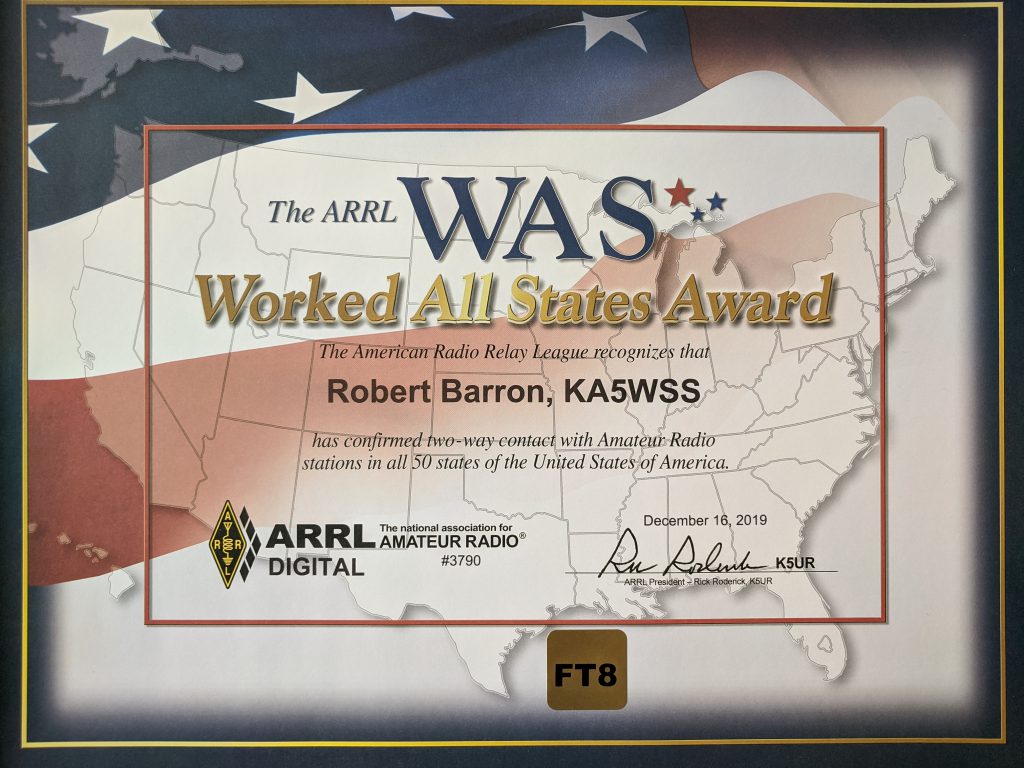The American Radio Relay League’s (ARRL) Worked All States Award (WAS) is one of the most prominent domestic awards in Amateur Radio. To obtain the award applicants must submit proof of having worked another Amateur Radio station within each of the 50 states that make up the United States of America.

I recently achieved WAS from my home station and fired off applications for both the Mixed and Digital versions of the award.
Flavors
The award comes in many flavors, providing the applicant with a multitude of goals to shoot for even after the first award is obtained.
| Mixed | Phone | CW |
| Digital | RTTY | Satellite |
| 5 Band | 160 Meters | 50 MHz |
| 144 MHz | 222 MHz | 432 MHz |
| 1296 MHz | Triple Play |
But the fun doesn’t stop there. Many of the awards above can be affixed with endorsement stickers. For example, the Digital WAS can be endorsed after working all states specifically with the FT8 mode. The Mixed award can be endorsed for working all states solely on the 20M band. I’ll leave the math up to you, but that will obviously add up to a lot of options and goals.
Requirements And Costs
Applicants within the United States, or any dependencies, must be members of the ARRL to apply for the award. Amateurs residing elsewhere do not need to be members of the League.
All Amateur Radio bands may be used for contacts with the exception of the 60M band. Obviously, single band awards are limited to the band in question.
Many politicians often ask, what do we do about Washington, DC? That complicated question has a simple answer in this case. Simply count DC as part of Maryland for the purposes of this award.
All contacts for any given award must be made from locations within 50 miles of each other.
Applying for the award is easy, particularly if you do so via the Logbook of the World (LoTW). The ARRL’s electronic QSLing system can keep track of your valid contacts for a given WAS flavor and then applying for a certificate or endorsement sticker is simply a matter of pressing a few buttons. In such cases you need not send physical QSL cards for checking.
The physical award ships in a sturdy cardboard tube. The handsome, colorful certificate fits in any standard 11×14 frame. Though there are no marked spaces for endorsement stickers but there is ample room in the margins to affix them.
The total cost of the award varies depending upon whether you apply for the award via LoTW, use mailed in paper QSL cards or apply for more than one award version at the same time. Check out the official page for the details but as of 2020 it generally boils down to $17.00 for the mailed certificate. Endorsement stickers cost $2.00. Applying via LoTW incurs a $5.00 fee but return shipping for physical QSL cards starts at $9.00. So LoTW is still clearly the best way to apply.
Approachability
WAS is the ARRL’s most popular award, even more so than the older, more venerable DX Century Club (DXCC). The reason is because it’s easier for stations of modest means to achieve. Given some time and patience, even a simple home station with a wire dipole can work all 50 states. Modern digital modes like FT8 help make the task even easier.
My own home station sits on a small city lot. The sole HF antenna used to obtain my WAS was a simple end-fed long wire antenna running along the top of a privacy fence. This sits no more than about eight feet off the ground, far from ideal. Even with these limitations, the WAS award is achievable. Unlike some of my DX awards, I specifically targeted this one to be worked solely from my home QTH just to say I did it.
This was super helpful, thank you!